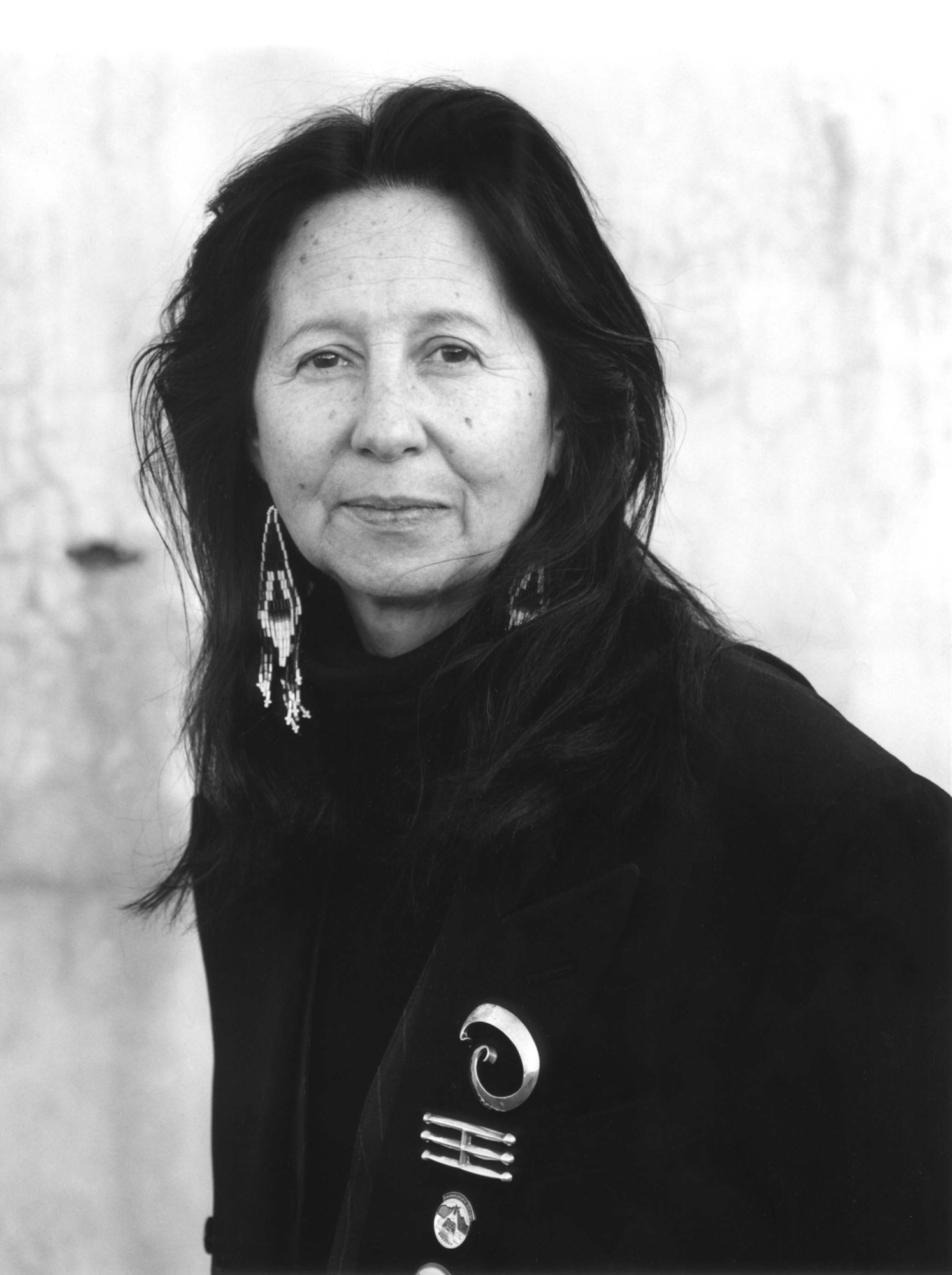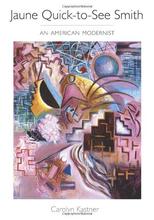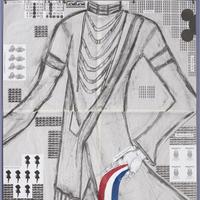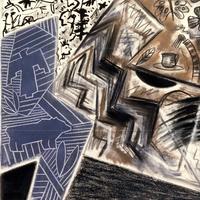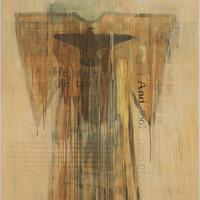More about Jaune Quick–to–See Smith
- All
- Info
- Shop
Works by Jaune Quick–to–See Smith

Contributor
Jaune Quick-to-See Smith is the first Native American artist to have her work acquired by a national gallery.
Get ready to feel the outrage when you realize this purchase only happened in 2020, when The National Gallery of Art in Washington, D.C. finally welcomed I See Red: Target into their collection. Smith, like many of us when we first heard this, was shocked to realize there had not been another Native American artist whose work had been purchased by a national museum. It’s no wonder her body of work often deals with the alienation of Native Americans in the United States. Like, obvi.
It’s thanks to her dad that Smith began dabbling in art from a young age. As a young girl, Her artwork were created by drawing in the dirt with sticks, and using rocks to make things. There was even a time in her teenage years that she dressed as Henri Toulouse-Lautrec. And yes, she wore a beard, beret, and held onto a paint palette.
Smith was born on the Confederated Salish and Kootenai Reservation when her mother was only fifteen. Smith's name is as unique as a thumbprint, as a snowflake, as the artist herself. Jaune Quick-to-See Smith. Not Jane or Juan, and it sounds like yawn. It’s a unique name that hails from the French word for yellow, and Quick-to-See, which, from her grandmother, means “insight, perception.”
Horses feature plenty in Smith’s artworks. They’re a frequent motif, influenced by her father, a horse trader, and rodeo rider. That isn’t the only influence he’s had on his daughter. Her father often worked around the house, fixing the roof, shingles, and fences, and she cites him as being one of her early inspirations. There have been corrals the father and daughter duo built together which remain treasured sculptures to Smith. The family traveled up and down the West Coast, moving houses about fifty times thanks to her father’s work with horses. Not a bad way to see the country.
When school was out, Smith labored as a migrant farmworker. Every student needs a job or two while they’re completing college, and Smith definitely had her plate full. She had a mismatch of odd jobs as she worked towards finishing her bachelor’s degree in art education and raising three kids: waitress, pre-school teacher, factory worker, bookkeeper, housemaid, librarian, janitor, veterinary assistant, and secretary. On top of working and raising three kids, the naysayers out there tried to deter her. In ’58, there was a professor who informed Smith that females couldn’t be artists. Instead of telling this braindead dude to go stick it where the sun don’t shine, Smith enrolled in a master’s degree program (which took her twenty-two years to finish) and invested full-time in artmaking. Smith became politically vocal at the 500th anniversary of the arrival of Christopher Columbus, and used Barbie and Ken figurines to artistically express her protest.
Smith is green-minded when it comes to making art. She’s not just recycling dolls. The artist, who grew up in rural reservations, uses biodegradable materials in her artwork. Don’t be shocked to see charcoal and rag paper making an appearance. It’s part of her roots to be concerned for the environment, as she grew up learning that taking care of the land was an important responsibility.
She's also never slowed down in her art practice. In the last four decades, she has been part of 680 group exhibitions and rocked 125 solo exhibitions. Why stop now? The National Gallery purchase is but one step toward the recognition of Native American artists in the art world.
Sources
- AP News, “National Gallery of Art acquires painting by Native American,” AP News, July 6, 2020. Accessed August 21, 2020. https://apnews.com/ff917ab8ea953d6a629cd4f9a15ec115
- Bjornland, Karen, “Indian artist says vivid images reveal stereotypes that linger,” Daily Gazette, September 27, 2014. Accessed August 21, 2020. https://dailygazette.com/article/2014/09/27/indian
- Desmond, Kathleen K. Ideas About Art. West Sussex, UK: Wiley-Blackwell, 2011. Chapter “Made in America.”
- Erin Allen, “5 fast facts: Jaune Quick-to-See Smith,” National Museum of Women in the Arts, February 25, 2019. Accessed August 21, 2020. https://nmwa.org/blog/5-fast-facts-jaune-quick-to-see-smith/
- Kastner, Carolyn. Jane Quick-to-See Smith, An American Modernist. Albuquerque: University of New Mexico Press, 2013.
- Neely, Liz, “Exploring the landscapes of Jaune Quick-to-See Smith,” Georgia O’Keefe Museum, July 10, 2020. Accessed August 21, 2020. https://www.okeeffemuseum.org/exploring-the-landscapes-of-jaune-quick-t…
- Sayej, Nadja, “‘It’s like we don’t exist’: Jaune Quick-to-See Smith on Native American artists,” The Guardian, July 29, 2020. Accessed August 19, 2020. https://www.theguardian.com/artanddesign/2020/jul/29/jaune-quick-to-see…
- Smith, Jaune Quick-to-See, interview by Dolores Brandon, The Bernice Stelnbaum Gallery, New York City, February 1990, transcript, The Chief Seattle Series (1990), DoloresBrandon.com. Accessed August 21, 2020. http://doloresbrandon.com/interviews/jaune-q-s
- Stock, Christina, “From the vault: ‘Ghost Dance’ by Jaune Quick-to-See Smith,” Roswell Daily Record Online, January 21, 2019. Accessed August 21, 2020. https://www.rdrnews.com/2019/01/21/from-the-vault-ghost-dance-by-jaune-…
- Gary White, “Soft-spoken Jaune Quick-to-See Smith doesn’t shy away from political themes in her work,” The Ledger, July 30, 2005. Accessed August 21, 2020. https://www.theledger.com/article/LK/20050730/News/608112483/LL
- Zimmer, William, “Drawing visual power from a social cause,” New York Times, December 22, 1996. Accessed August 21, 2020. https://www.nytimes.com/1996/12/22/nyregion/drawing-visual-power-from-a…
Featured Content
Here is what Wikipedia says about Jaune Quick-to-See Smith
Jaune Quick-to-See Smith (January 15, 1940 – January 24, 2025) was a Native American visual artist and curator. She was an enrolled citizen of the Confederated Salish and Kootenai Tribes and was also of Métis and Shoshone descent. She was an educator, storyteller, art advocate, and political activist. In her five-decades-long career, Smith gained a reputation for her prolific work, being featured in over 50 solo exhibitions and curating more than 30 exhibitions. Her work draws from a Native worldview and comments on American Indian identity, histories of oppression, and environmental issues.
In the mid-1970s, Smith gained prominence as a painter and printmaker, and later advanced her style with collage, drawing, and mixed media. Her works have been widely exhibited and many are in the permanent collections of prominent art museums including the Museum of Modern Art, the Whitney Museum of American Art, the Metropolitan Museum of Art, Denver Art Museum, Modern Art Museum of Fort Worth, and the Walker Art Center as well as the Smithsonian American Art Museum and the National Museum of Women in the Arts, both in the District of Columbia.
Her work has also been collected by New Mexico Museum of Art (Santa Fe) and Albuquerque Museum, both located in a landscape that has continually served as one of her greatest sources of inspiration. In 2020, the National Gallery of Art bought her painting I See Red: Target (1992), which was the first painting on canvas by a Native American artist in the gallery.
Smith supported the Native arts community by organizing exhibitions and project collaborations, and she also participated in national commissions for public works. She lived in Corrales, New Mexico, near the Rio Grande, with her family. Smith was represented by the Garth Greenan Gallery in New York City.
Check out the full Wikipedia article about Jaune Quick-to-See Smith

